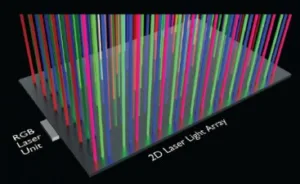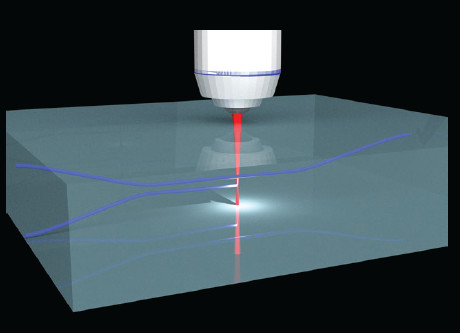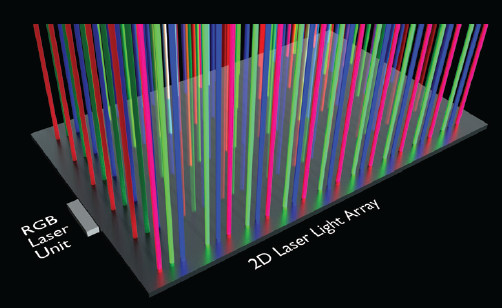One of the presentations from the recent SID DisplayWeek virtual event was from Vienna-based VitreaLab. They described a new RGB laser light engine that can be used as a backlight for conventional LCD displays or even to illuminate a spatial light modulator (SLM) to create a holographic display. I spoke with co-founders Jonas Zeuner and Chiara Greganti about their technology.

They are both young entrepreneurs with fresh PhDs with four pending patents. They have received their first round of seed capital, built a development lab, are working with two Universities (University of Wien and CNR-IFN),.
First, the idea of using lasers in a backlight is not new. Designs I remember have typically used the laser to fill the backlight using total internal reflection and extraction structures to homogenize the light and extract it toward the LCD panel, just as conventional LED-based backlight units do.
VitreaLab has a different approach. By using a laser writing technique in the glass backlight, they can create millions of tiny (a few microns) single-mode waveguide elements to direct laser light to each-and-every sub-pixel in the display. A tiny mirror is also placed below each sub-pixel to extract the light toward the LCD panel.
There are many potential benefits to this approach. For one, the laser light is polarized and the polarization is not destroyed when traversing the waveguide. That means nearly a 50% boost in brightness (or reduction in power) immediately. And, one can eliminate the color filters. Both combine to offer either an 80% reduction in power or a 5X luminance boost. Secondly, the light should emerge with better collimation reducing cross talk and increasing the native contrast of an LCD panel. Thirdly, by choosing the wavelengths correctly, one should be able to achieve >95% of the BT.2020 color gamut coverage.
So far, the team has demonstrated small scale prototype arrays showing the concept works and produces red, green and blue light. Over the next year, they plan to develop a more comprehensive developer kit with a prototype that potential customers can use to better evaluate for their particular application. They will also need to work on improving efficiency and prove out mass -production capabilities.
Zeuner and Greganti told me that they are using industrial grade lasers to “write” the waveguides in the glass backplane, but they did not disclose the wavelength or other process parameters as these remain trade secrets. Development of this writing process to speed it up and ensure accuracy and uniformity is on their to do list.
The mirrors needed for extraction is done with a nano imprinting fabrication technique and can be easily sourced from multiple companies. This is a single sheet solution, they said. The challenge is to create 3D paths in the glass backplane that can route laser light from only a few laser sources to the millions of subpixels in a display – and deliver them at the right angle to extract them perpendicular to the LCD panel. This is the secret behind their technology so Zeuner and Greganti were unable to be more specific on this process.
A single bank of RGB laser diodes can be used to power phone-sized displays with additional lasers needed for larger screen sizes. Such lasers should be available for around $1 each in high volume production, they estimate.
Local dimming is also possible depending on how you route the laser beams from various laser banks, but I wonder if this would even be necessary if they can optimize the contrast and finely modulate the lasers.
There is also the possibility to use this backlight to make larger-sized true holographic displays. Holographic displays today are mostly made using laser light and spatial light modulators fabricated using specially-formulated LCOS microdisplays. The laser backlight opens up the potential to use a standard LCD panel and to write a phase hologram to the panel instead of a raster-based image. This will take a lot of development work but is a very intriguing possibility. (CC)
Chris Chinnock is an industry analyst and writer serving clients in emerging display ecosystems such as mini/micro-LED, 8K, light field/holographic and AR/VR/MR. He also serves as executive director of the 8K Association.




